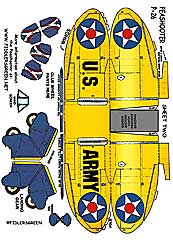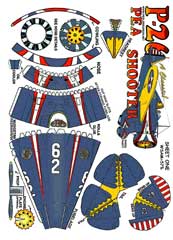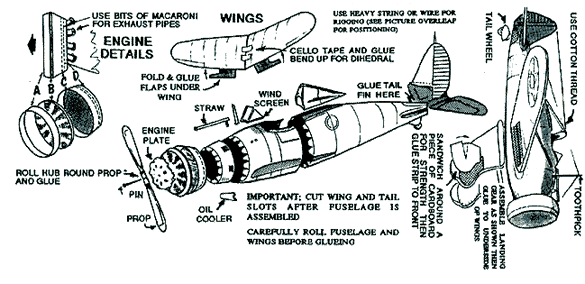


P-26 Peashooter - $$5.50
The American Boeing P-26, nicknamed the "Peashooter", was the first all-metal production fighter aircraft and the first pursuit monoplane used by the United States Army Air Corps. The prototype first flew in 1932, and were used by the Air Corps as late as 1941 in the Philippines.
This Fantastic Boeing P-26 Peashooter.


Known affectionately as the Peashooter, the Boeing P-26 single-seat fighter was one of the most distinctive monoplane designs of the 1930s, combining several forward looking features with others that, in retrospect, seem outmoded by comparison. It retained a well streamlined but nonetheless drag-creating fixed landing gear, yet at the time of its design (1931) Boeing was installing retractable gear in its B-9 bomber. At the same time, its low-wing monoplane layout and all-metal construction were truly modem features, even though the wings were somewhat extensively braced. It was, in fact, the first all-metal monoplane production American fighter.
The P-26, Boeing's last production fighter, originated with three private-venture prototypes, known as the Boeing Model 248, designed and equipped with minimal assistance from the USAAC. Two of these aircraft were in due course evaluated in 1932 by the Army which in January 1933 ordered 111 examples of an improved version under the designation P-26A. An originally built, ailerons were the P-26As only wing control surfaces, but all aircraft in service later had flaps fitted. The first P-26A began to be delivered in December 1933, and they soon became standard pursuit squadron equipment in Hawaii and the Panama Canal area. A subsequent contract was placed for a further 25 fighters, two of these (designated P-26B and delivered in June 1935) having fuel injection engines. The remainder were delivered from February 1936 initially as P-26Cs, having the name power plant as the A model and minor control system changes, but later many were converted to B standard.
This toy-like airplane just barely made it to the World War II by fighting in the very first Japanese air attacks in China. If you only make Fiddlers Green model, you just gotta do this one! It's not the easiest model but it's well worth the bit of extra trouble. I ran a little straw up the center of the fuselage and use it as a real peashooter blasting unsuspecting friends as they come and look closer at the cute little model clenched in my teeth. A zillion laughs!

|

|

|
Bamboo tip (and photos) from Bob Lutz
One day, I split one of those "curl on the end" bamboo toothpicks because I needed a thinner gage. I thought "Wow, that was easy...let's see how far I can split this?" Answer: down to a human hair! So, I got out my 12" long ke-bab bamboo skewers and started splitting them. Result is bamboo reeds that are the gage of thread, but much easier to apply for rigging. They are straight, stable, resilient and easy to paint with Sharpies. I did the P-26 rigging in bamboo slivers in 20% of the time needle and thread would have taken, and with no holes poked anywhere. I like the result, too.
Boeing P-26

 Between the late 1920s and the late 1930s the world's aircraft
constructors and air forces made a technical transition greater
than any that has happened before or since. From simple fabric-covered
machines identical in form to those that fought World War I, designers
moved on to all-metal monoplanes which eventually had stressed
skins instead of bracing wires and Struts' and incorporated such
new features as retractable landing gears, flaps and variable-pitch
propellers. Of all the fighters which appeared while this great
change was taking place, none exerted a greater influence than
the Boeing P-26.
Between the late 1920s and the late 1930s the world's aircraft
constructors and air forces made a technical transition greater
than any that has happened before or since. From simple fabric-covered
machines identical in form to those that fought World War I, designers
moved on to all-metal monoplanes which eventually had stressed
skins instead of bracing wires and Struts' and incorporated such
new features as retractable landing gears, flaps and variable-pitch
propellers. Of all the fighters which appeared while this great
change was taking place, none exerted a greater influence than
the Boeing P-26.
This was Only to be expected, because the dominant characteristic of Boeing aircraft has be that they are technical leaders. The company first began to stride purposefully ahead of its rivals in the final months of the 1920s, when it designed a cantilever monoplane mailplane, the Monomail. Then followed the impressive B-9 twin-engine bomber, and the last of the trio was the Model 247 transport.
Each broke an exceptional amount of new ground, though as far as production orders were concerned, Boeing sometimes lost out to rivals who, seeing what Boeing had done, jumped in a few months later with something even better. Without the example of the B-9 it is unlikely that Martin would have designed the B-b which beat the Boeing and secured large production contracts.
Without the spur of the 247, which was an outstandingly advanced machine for its day, it is doubtful whether Douglas would have created such a machine as the DC-1, flown a few months later and sire of all the famed "DC' transports. But with the next model, the 248, Boeing had no immediate competitor. The 248 was the P-26. popularly called the 'Peashooter' and one of the classic combat machines of the inter-war period. Unlike the Monomail, B-9 and 247, the P-26 was not conceived entirely as a private venture by the Boeing Airplane Company, as it then was styled.
Since the earliest involvement in World War I. Boeing had worked closely with the US military establishment, and it is one of the minor puzzles of aviation history that such progressive designs as the Models 214 and 215, which became the B-9 family after evaluation by the Army Air Corps, should have had to go ahead on company funds only. Clairmont L. Egtvedt, who then held the posts of vice-president and general manager and was later company chairman, simply stated that in 1930 military money was almost non-existent. In his view it was even more remarkable that, in building the new fighter in 1931, Boeing should have been able to get any financial support from the Army Air Corps at all.In the case of the P-26, the Army's assistance was confined to the gratuitous supply of a Wasp engine, some instruments and equipment, and a very small sum-probably in the order of $1,000-to cover the cost of some static test programs.
Thus, though the
Army did offer some practical help  and sat around a table from
the start of the Model 248 concept, the whole project was virtually
a company venture. The Army never ordered anything at this stage,
and it may be that it was just happy to let Boeing go ahead. Had
the company declined, the introduction of better (monoplane) fighters
would probably have been considerably delayed. Design of the Model 248 occupied most of 1931. The aircraft
was an interesting compromise. It naturally had an all-metal monocoque
(single-shell) fuselage, and this was of pleasant and rather rotund
form with a smooth exterior skin. But in most other respects,
and very strongly held back by their conservative customer, Boeing
did not make all the advances they could have done.
and sat around a table from
the start of the Model 248 concept, the whole project was virtually
a company venture. The Army never ordered anything at this stage,
and it may be that it was just happy to let Boeing go ahead. Had
the company declined, the introduction of better (monoplane) fighters
would probably have been considerably delayed. Design of the Model 248 occupied most of 1931. The aircraft
was an interesting compromise. It naturally had an all-metal monocoque
(single-shell) fuselage, and this was of pleasant and rather rotund
form with a smooth exterior skin. But in most other respects,
and very strongly held back by their conservative customer, Boeing
did not make all the advances they could have done.
The wing was not a cantilever, as it was in the Monomail, 247 and B-9, but was braced by multiple wires, most of them in pairs. The landing gear was fixed, with distinctive spats and linked into the system of wing bracing wires. The 522hp Pratt & Whitney SR-1340E engine was cowled by a simple short-chord NACA ring, and drove a Hamilton metal propeller with no pitch-change mechanism. The cockpit was open, and the armament was almost retrograde, comprising a single 030in machine gun with provision for a second. Provision was made for light bombs under the tubby fuselage. Boeing constructed three prototypes, two for flight development and the third for static testing.
The first flight prototype flew on 20 March 1932. Handling was extremely satisfactory, and level speed was remarkable, the highest maximum, reached at about 6,000 ft being over 230mph, an improvement of more than 40mph over the biplane fighters with the same engine. Later in 1932 the Army Air Corps tested the two flight prototypes with the designation of XP-936, the 900 series style showing it to be a civil aircraft in Army hands.
The results were so good that all three prototypes were purchased, receiving the Army designation XP-26. Later this was changed to YP-26 at the service test stage. In January 1933 the Army ordered 111 Boeing Model 266 fighters with the designation P-26A. These differed mainly in equipment and constructional details which had already been tested on the prototypes, such as an improved exhaust system and a slightly taller pilot's headrest fairing.

Dangerous landings Boeing soon filled the Seattle plant with the new monoplane pursuits, which were delivered between 10 January and late June 1934. Meanwhile work went ahead on a company prototype, without Army influence, The Model 264 was a more advanced pursuit that embodied Boeing's own thinking, in having a stressed-skin wing without external bracing wires, a retractable landing gear, more powerful Wasp engine with long-chord NACA cowling. and an enclosed cockpit. It was slightly larger than the P-26. and appreciably heavier, but had a speed raised to at least 250mph and range extended from 550 to 800 miles.
Another prototype, the Model 273, was a quite different pursuit for the Navy. Eventually the Army Air Corps bought three Model 264s, with designations YP-29, YP-29A and YP-29B, but after trying to eliminate the controversial new features-such as the NACA cowling and cockpit canopy- plans to adopt the P-29 were abandoned. Likewise the Navy decided against the Model 273, though it tested it as the XF7B-1. This was an even more advanced machine, with flaps and a two-position bracket-type Hamilton propeller, but the Navy decided to continue buying biplanes from Curtiss and Grumman.One of the chief factors that bothered both the Army and Navy was that the new monoplanes landed faster than the biplanes. The P-26A landed at about 73mph, which in 1934 was considered dangerous and a severe operational shortcoming.
There were virtually no airfields with runways, and the rough grass airfields tended to overturn the 'Peashooter' unless the pilot was exceptionally skilled. For this reason the P-26A was used mainly at bases with long strips of sun-baked earth in the southern and western United States, Hawaii and the Canal Zone. In service the headrest was again deepened, and the aircraft were fitted with flotation gear and, for the first time in an operational Army pursuit, two-way radio. Most important of all, the aircraft were recycled back through the Boeing factory to be fitted with flaps. These were of the split type, operated hydraulically by a pump on the engine or energized by a manual pump lever in the cockpit. They were quite powerful, though primitive, and significantly lowered the landing speed. All these modifications were completed during 1934. In 1934 Boeing received an order for a further 25 pursuits, two of which were delivered with SR-1340-33 fuel-injection engines with the designation P-26B. while the rest had the standard engine but minor systems changes,, especially to the fuel system, and were called P-26C. All were later fitted with the -33 engine, though still called P-26C. The nippy Boeing monoplanes were not reckoned to be easy aircraft for a novice to handle, but they were well-liked and certainly exciting performers.

Into combat, Boeing also secured an export order for 11 Model 281 pursuits, similar to the P-26A apart from military equipment, from China. A 12th aircraft was sold to Spain, apparently before the start of the Civil War in 1936. All these Model 281 export aircraft were fitted with flaps before delivery. In 1935 the 11 Boeings were the most formidable element in China's defensive air power, and most of them were in action against Japanese aircraft at the start of the Sino-Japanese war in 1937.
As for the US Army Air Corps machines, these were gradually replaced from 1936 by the Seversky P-35 and Curtiss P-36, which were considerably more powerful and more costly. After service with the US Army the surviving 'Peashooters' found a ready market among other air forces. Those of the squadron serving at Albrook Air Force Base, in the Canal Zone, were sold to the Republic of Panama. Those in the Hawaiian Islands and Philippines were passed on to the Philippine Army Air Corps, and several were in combat with Japanese aircraft in December 1941.
Of course, by World War II the little Boeing monoplane was obsolescent, and it was no match for a 'Zero'. Even so, many of these famed little fighters did eventually go into action against Japanese aircraft, over both China and the Philippines, though records of how they stood up to their more modern adversaries are sparse; apparently very few Peashooters' lasted far into 1942.
The P-26 in Guatemala, The last country to use the P-26 operationally was Guatemala. It bought a few direct from the US Army Air Corps in 1937 and also purchased the surviving aircraft from Panama during World War II, and several were still in service with the Guatemalan Air Force as late as 1953. Even as late as 1957 a few were still to be seen on the Guatemalan military airfields of Puerto Barrios and San Jose, but it is doubtful that they were flyable. Today two 'Peashooters' from the original P-26A production batch are being preserved in museums. One, formerly serialled 33-123, is in California at the Planes of Fame museum at Buena Park, Los Angeles. The other, 33-135, is on display at the National Air and Space Museum in Washington.
The P-26 served with USAAC pursuit and attack squadrons at home and overseas, but by 1940 had been replaced the Curtiss P-36s and Seversky P-35s and relegated to training. The P-26 had a high landing speed - alleviated by flaps -. and poor soft-field landing characteristics, and was mainly used at bases with hard earth airfields in the south-western mainland and Hawaii. Many P-26As based overseas were sold to the Philippines and Panama; Guatemala purchased two, arid others later from Panama. Boeing built only 12 of aft export version, the Model 281, which differed only in details from the P-26A (Model 226A), also having flaps added. Between 1934 and 1936 11 were exported to the Chinese Air Force which used them successfully against Japanese raiders. One was exported to Spain.

Specifications for the Boeing P-26 Peashooter
 |
Length: 23 ft 7 in Wingspan: 28 ft Height: 10 ft Empty weight: 2,196 lb Loaded weight: 3,360 lb Powerplant: 1× Pratt & Whitney R-1340-7 "Wasp" radial engine, 600 hp Performance Maximum speed: 234 mph at 6,000 ft Combat radius: 360 mi Ferry range: 635 mi Service ceiling: 27,400 Armament Guns: 2× .30 in (7.62 mm) M1919 Browning machine guns Bombs: 1× 200 lb bomb |



